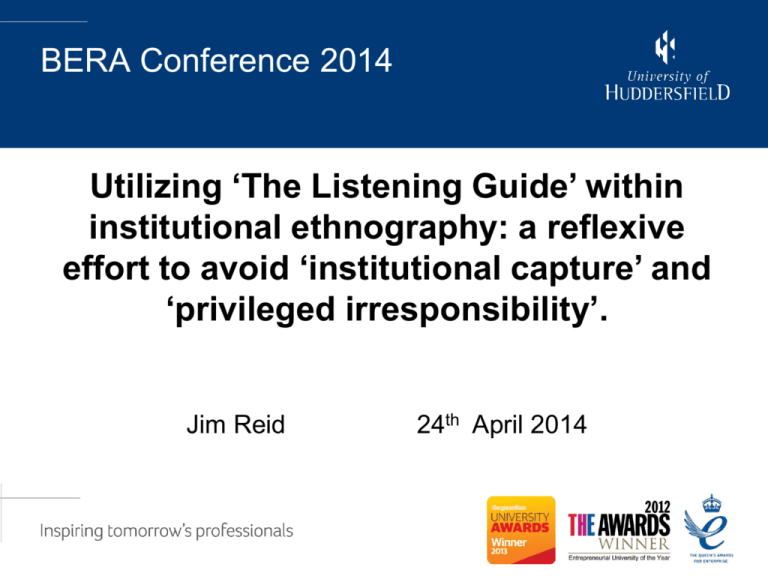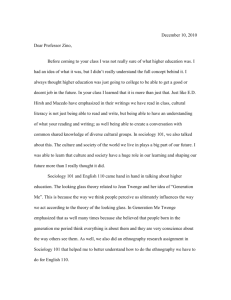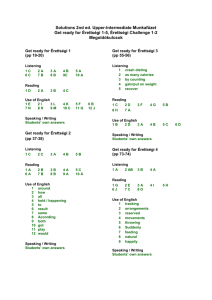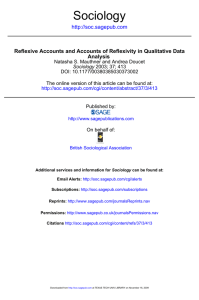Document
advertisement

BERA Conference 2014 Utilizing ‘The Listening Guide’ within institutional ethnography: a reflexive effort to avoid ‘institutional capture’ and ‘privileged irresponsibility’. Jim Reid 24th April 2014 Context • Institutional ethnography (Smith 2005) – Problematic is ‘how teachers come to care’. – Small urban primary school – Notice to improve • “Are you a spy from Ofsted?” – All female staff team – Catchment area for the school most deprived in ward / worst 20% nationally • The Listening Guide (Mauthner and Doucet 1998) Institutional ethnography – Valuing participants • Dorothy Smith (2005) posits ‘a sociology for people’ that focuses on textually mediated social organization of people at work. – Historically and discursively mediated institutional technologies. Relations of ruling, intertextuality, material and artefacts. • Standpoint - the researcher must start from the experience of people and avoid objectifying people to predominant ideologies and approaches. – standpoint returns us to the actualities of our lives as we live them in the local particularities of the everyday/everynight worlds in which our bodily being anchors us • Research beings in local sites of activity which are located throughout society. – Generalizable to other sites and wider networks of experience • Each of these helps to avoid value laden, ‘dichotomised oppositions’ (Prout 2011) achieved through other sociological approaches The need for reflexivity • Iterative process • ‘Institutional capture’ and ‘bifrucation of consciousness’ (Smith 2005) • Participants must be objectified to IE’s social ontology and constitutive hermeneutic, particularly the researcher’s focus on texts. Less clear on the mediating power of a ‘sociology for people’ or its own ‘social relations of research’ (Walby 2007) • Paucity in the literature critically evaluating the technical aspects of IE – data generation, data analysis, reflexivity. • ‘Care’ and hence care research is political. Reflexivity is an aspect of the personal, social, moral and political exchange between research and participant (Tronto 1993). The Listening Guide Mauthner and Doucet’s (1998) The Listening Guide. 4 readings The Listening Guide is used to foreground the voice of the participants and utilises qualitative collection of data, for example, interviews to achieve this. Reading for plot and reflexivity (reading 1) Reading for the voice of I (reading 2) – understanding how the informants speak of themselves rather than how the researcher speaks for them Reading for relationships (reading 3) – all informants are understood as intrinsically relational and as part of networks of relations. Placing people within cultural contexts and social structures (reading 4) - the narrative is explored within broader political, cultural and structural contexts. Aligning IE and The Listening Guide • Theoretical underpinnings in feminisms’ approach to power and social relations. • Narrative as a feature of data and the potential to explore text-reader conversations. • Reflexivity as a tool in explicating the approach used within the study and the synthesis between theory, method and ethics. • People’s doings are socially produced. The analytical structure of The Listening Guide may have been forged by cognitive-developmental psychology but the analysis of data is not predetermined by any overarching theory or normative concern. Data analysis and the explication of the mediating power of texts are iterative (Walby 2013). My ‘I’ poem I appreciate… fairness, respect and honesty I am more than interested I bring to the field I have experienced violence, fear, discrimination I am attracted to a field I am certainly interested I identify with that profession I have to demonstrate my compliance I acknowledge the time and commitment I believe this is the ethical thing to do I am the only male I inevitably record I am drawn into conversations I am asked a question I answer honestly I might have given I think this is an appropriate approach I am compelled to work I made her think I have come to appreciate I, as an observer. The outcome • Emancipatory power – it’s like the first time anybody has ever listened to me’. – ‘I’m really proud of what I have achieved’ • you're you not a spy from Ofsted which is what I thought you were when you first started coming. References • • • • • Mauthner, N.S. and Doucet, A. (1998). Reflections on a Voice-Centred Relational Method of Data Analysis: Analysing Maternal and Domestic Voices. In Jane Ribbens and Rosalind Edwards (eds.). Feminist Dilemmas in Qualitative Research: Private Lives and Public Texts. London: Sage. Prout, A. (2011). Taking a Step away from Modernity: reconsidering the new sociology of childhood. Global Studies of Childhood.1 (1) 4-14. Smith, D.E. (2005). Institutional ethnography: A sociology for people. Toronto: Altamira Press. Tronto, J.C. (1993). Moral Boundaries. A Political Argument for an Ethic of Care. London: Routledge. Walby, K.T. (2007). On the Social Relations of Research: A critical assessment of Institutional Ethnography. Qualitative Research, 13 (7) 10081030. doi: 10.1177/1077800407305809.








